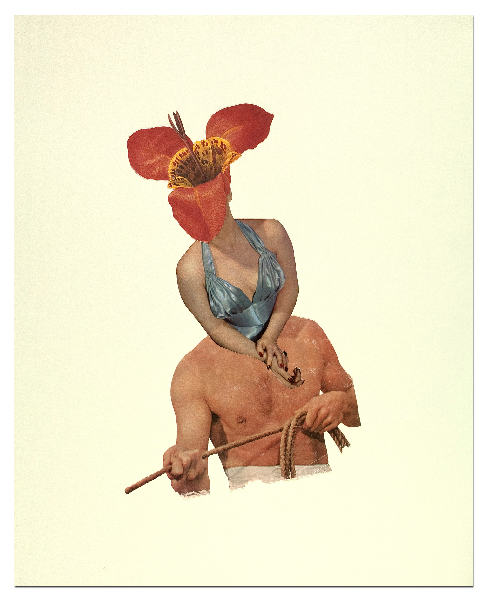 |
Curated by Ric Kasini KadourEach print issue of Kolaj Magazine presents an Exhibition-in-Print as a means of exploring critical ideas about collage. We examine work related to a curatorial premise, identify themes and ideas. The purpose is to develop and share an understanding of collage as a medium and a genre. "Broken Bodies" originally appeared in Kolaj #11. Enjoy! |
 |
Bodies are so fundamental to the human experience that we often forget we have one. We are more likely to be aware of another’s body than our own. We engender people. We attribute all sorts of assessments to someone based on their height, weight, frame, or how they carry themselves. We lust after or are repulsed by others’ bodies. Or, we pretend not to notice their bodies at all. We reserve our harshest judgments for ourselves, however, constantly wondering if we are too fat or too thin, attractive or not, healthy or not, aged or not. Naked, we are either aroused or ashamed, rarely simply nude. Some of us feel we are in the wrong bodies. Some of us take on the project of remaking our bodies, through diet or surgery or exercise. It is no wonder that we disassociate ourselves from our bodies, so much so that a wellspring of self-help literature exists with the lone purpose of “reconnecting” us with our bodies. |
All this transfers to art in a variety of ways. Sometimes, the body is completely disregarded. The study of portraiture, for example, rarely examines how the body is rendered. By contrast, figurative art is obsessed with every muscle, every skin tone, every fleck of pubic hair to the point where the body becomes a dehumanized landscape of flesh. Nudity is celebrated or censored, sometimes both. Masaccio’s Adam and Eve Banished from Paradise (1427) was celebrated for its naturalistic figural representation: the artist’s ability to paint what 15th century sculptors were doing with marble. And yet, during the reign of Cosimo III de’ Medici in the late 17th century, the genitals of the figures in the painting were deemed offensive and covered with paintings of leaves. This act of collage wasn’t reversed until the original frescoes were restored in the 1980s. |
This exhibition-in-print examines collage that uses the body as a terrain for exploring or expressing ideas and in particular bodies that are deconstructed and reconstructed, where body parts are added, removed, or exchanged for other objects. These bodies are broken, cut, torn, reassembled, and fraught with a host of contemporary anxieties about gender, identity, physicality, and how we as a society make sense of it all. The bodies in these works of art are dehumanized; made into machines or animals or piles of parts…broken. But in presenting the body in this manner, the artist is asking us to put the bodies back together, to re-humanize them, and in doing that, reflect upon a broken humanity, a humanity that is sometimes tortured, sometimes comical, and often hovering somewhere in between. Opening Image: Come to Me by Richard Russell (20"x16"; collage on paper; 2014) |
Sherry Parker
|
RECONSTRUCTION
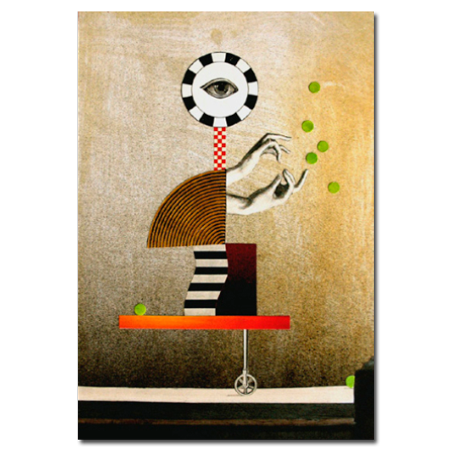
Making Magic by Sherry Parker
Santa Rosa, California-based Sherry Parker spent much of her professional career in advertising and marketing and, as such, her collages show a refinement akin to graphic illustratration. Because of the nature of the medium, bodies in collage are almost always constructed of various parts. In Parker’s Making Magic, those parts are assembled, but of constructivist shapes and patterns (think El Lissitzky shapes, Aleksander Rodchenko patterns), and presented in a Bauhausian composition reminiscent of László Moholy-Nagy. Vintage hands juggle lime green dots. Parker writes about being excited by collage’s ability to communicate ideas through “serendipitous discovery". Her collages are like puzzles that you take apart, the meaning of which is found only when all the pieces are separated from each other. Through composition, Parker gives the viewer just enough order to suggest a body. The eye lets you know the circle is a head, for example. The viewer, comfortable with the suggestion of a narrative—I am looking at a figure—must then engage in the play of making sense of it all. That is the magic being made. |
MIXING GENDERS
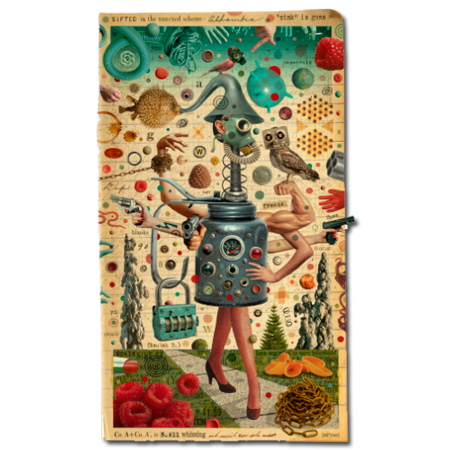
Sifted in the Annexed Scheme by Michael Waraksa
The body in this collage conveys a powerful comment about freedom, bondage, and identity. With six arms and the body of an oil can, a human head obscured under a gas mask, and a funnel hat that connects to a blowfish, the figure alone is given a lot to unpack in Waraksa’s collage. Waraksa’s fluid use of gender is expressed by limbs. The svelte legs in heels, the hand placed on the hip give the figure a sexy, feminine attitude. The muscular bicep and thick fingers of the hand pointing a gun at the viewer express a violent masculinity that contrasts with handgun-wielding hands sporting fire engine red nail polish and a lanky arm bound in chains. The result is a swirl of elements—revolution and bondage, self-protection and vulnerability, gender mixing—that suggests the figure moves along his or her path with a fierce mix of strategies. |
LOST IDENTITY
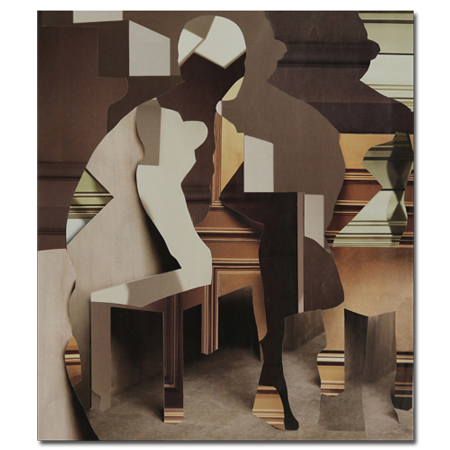
Slow Burn by Paul Loughney
Loughney’s collage “depicts reconfigured images of interiors and explores the tension left behind by the absence of the figure. This absence, exemplified by the negative shapes and shadows, renders various instances of time and place and produces an entirely new narrative and presence." The body in the collage is portrayed as empty space, made of pieces that could just as easily be found in its environment. While one could see this body as invisible and a reflection of the world around it, it can also be seen as a substance made of the world around it. This collage evokes a sense of dissipation and lost identity.
|
ZOOMORPHISM
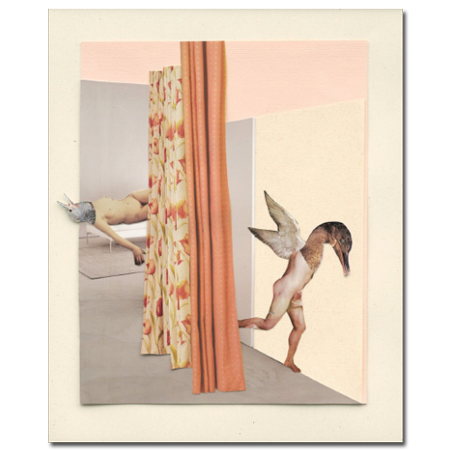
Retweet by Una Gildea
Löwenmensch is a 40,000 year old ivory sculpture of a human figure with the head of a lion. This Aurignacian artifact is the oldest example of zoomorphism in a long history of humans sticking animal heads on human’s bodies. Historically, these hybrid creatures were associated with religious mythology but in more modern times, they play an increasingly larger role in children’s literature. The portrayal of zoomorphed bodies in Irish artist Una Gildea’s Retweet suggest neither mythology—what gods would live with those drapes?—or childhood nostalgia--children’s characters are rarely nude. This collage is from the series “Tales of Seduction" where Gildea portrays attraction and seduction in narratives that are “at once oddly recognizable, yet uncomfortably odd; narratives often downright obscene, whilst pushing the chuckle-button; narratives that always aim to open the chute direct to the subconscious, that provoke an intuitive, not literal, sense, of what’s going on." The zoomorphism of the figures contribute to a sense of ridiculousness in a scene that would potentially be loaded with drama.
|
VIVISECTION
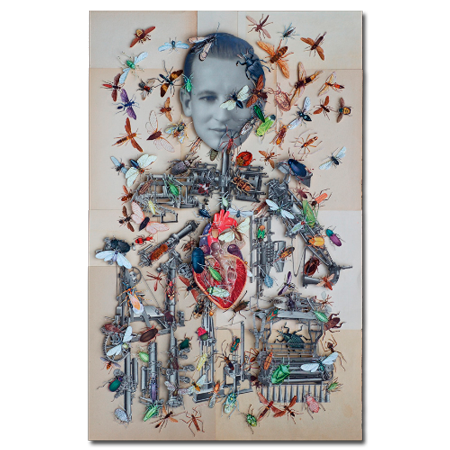
Ghost in the Machine by Hope Kroll
Where dissection applies to dead things, vivisection is an act performed on living things. Illinois-born, California-based Hope Kroll has been called a “paper surgeon" for her intricate and detailed cutting. Ghost in the Machine is a reconstruction of a figure whose body is inhabited by a diverse swarm of insects. The man’s parts are made of vintage machines. His heart is a cross-section. Kroll writes, “My machines more often than not tend to reflect a degree of inner turmoil or conflict in dealing with the outside world." One may be tempted to view the body in this collage as a metaphor for the psyche, but it is much more powerful to view it a literal representation of a vivisected body; the pieces within us on display for others to see. With this read, the collage becomes a comment on vulnerability and contemporary brokenness.
|
FLESH
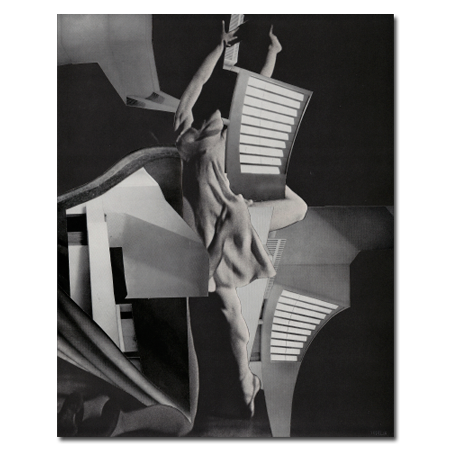
Virtuoso by Tres Roemer
The collages of Yellow Springs, Ohio-based Tres Roemer often explore the harmony of spatial configurations. The use of flesh in the centre of his architectural fantasia, Virtuoso, would be disturbing if it weren’t for the fact that in our visual culture flesh is often used as ornament or landscape. Roemer said about his work, “The precise juxtaposition of images allows an uninterrupted circulation within an individual work which ties these intricacies into the whole." As such, a reflection on this collage would not be complete without drawing one’s attention to the pair of legs in the lower left corner. These appear to be kneeling. The rest of the figure is obscured. The limbs at the top centre are almost hands reaching to the heavens. These gestures suggest an ecstatic frenzy of emotions. The use of architectural detail reinforces a sense of interior. And the use of flesh eroticizes the experience. |
DISFIGUREMENT
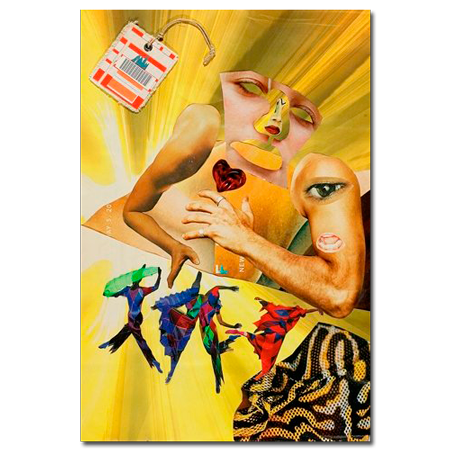
Hollow Rays by Ken Ralidis Nearly all of the bodies represented in this exhibition show disfigurement of some sort, but this collage allows us to look at the variety of ways in which collage can convey layers of experience in a single gesture. In this work, Ralidis isolates the nose and mouth, removes the eyes, and flays the remaining face as if a mask, suspended and detached. The arms are freed from their joints, connected to the body only by their position. The body itself is a graft of skin. All of these elements convey a sense of hollowness. Ralidis places an eye and an open mouth in the arm, which removes the body’s agency from the wholeness of the figure and places it in the arms. The heart of the figure is outside the body, reinforcing how empty the figure is. Ironically, the figure in this work is dancing, a point reinforced by the dancers in the lower part of the collage, which suggests that the joy the figure is experiencing is also hollow and empty. |
DISSIPATION
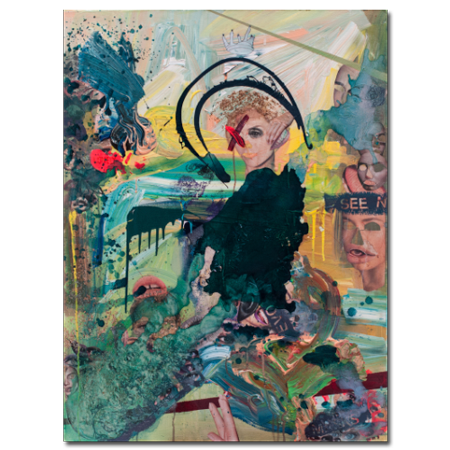
Lonely by Karli Henneman
Collage features prominently in the painting practice of San Francisco’s Karli Henneman. Lonely provides us with an example of how collage renders dissipation or an embodied indulgence that leads to a destruction. Lonely is about self-identity. The subject sees herself as a noble figure (note the multiple crowns above the head) in a swirl of paint and empty masks. With a look of disappointment, the figure’s body disintegrates into a goo of mouths and eyes and paint. Often, loneliness feels like one is isolated, separated from the world, but this piece refers to the loneliness one feels in a crowd. The collage elements in the body’s melting mass reinforce this notion. |
PATHETIC FALLACY
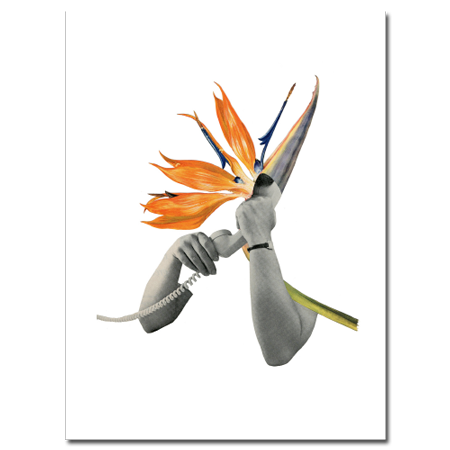
Phone Sex by Richard Russell
Pathetic fallacy is a term coined by John Ruskin in his 19th century masterwork, Modern Painters, as a way of attacking the sentimentality of attributing human emotions to nature. While Ruskin was making a critique, the idea expanded poetic expression and the term has lost its original negative connotation. Richard Russell’s Phone Sex is a comical illustration of this notion. A strelitzia, or bird of paradise, is anthropomorphized with a pair of arms. One hand gently strokes to curly cord of the handset which is held by the other hand to the invisible ear of the strelitzia. Russell accomplishes much in this simple collage, simultaneously mocking and celebrating the sexualization of flowers while erotizing the act of talking on the phone. The work underscores collage’s ability to express layers of meaning with fairly small, simple gestures. |
Thank you for viewing "Broken Bodies"Kolaj Magazine presents Exhibitions-in-Print as a means of exploring critical ideas about collage by examining work related to a curatorial premise. The purpose is to develop and share an understanding of collage as a medium and a genre. "The Face in Collage" originally appeared in Kolaj #11. Join the Kolaj Magazine Artist Directory || Call to Artists About Kolaj MagazineKolaj Magazine is a quarterly, printed magazine about contemporary collage. We are interested in how collage is made, how collage is exhibited, and how collage is collected. We are interested in the role collage plays in contemporary visual culture. We provide quality exposure for contemporary collage art. This full colour, internationally-oriented art magazine retails for $12.00. |
